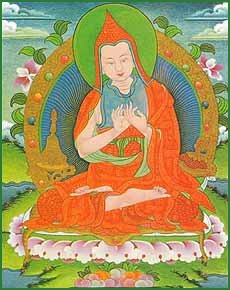The Great Chariot
by Longchenpa | 268,580 words
A Commentary on Great Perfection: The Nature of Mind, Easer of Weariness In Sanskrit the title is ‘Mahāsandhi-cittā-visranta-vṛtti-mahāratha-nāma’. In Tibetan ‘rDzogs pa chen po sems nyid ngal gso’i shing rta chen po shes bya ba ’...
1d.1) The general teaching of the three jewels
Now where proclaimers of the ordinary refuge have the power to take refuge, they request a refuge because they are afraid of themselves. It is explained that because they are worthy of the support of what the ritual of taking refuge proclaims, its nature was therefore taught:
The causal object is the three jewels concretely conceived.
Here the Buddha means the supreme nirmanakaya.
He is ornamented with the major and minor marks.
There are two kinds of Dharma: The Dharma of spotless meaning,
And also its reflection in a written form.
The meaning of sutras and tantras in the various vehicles
Is a reflection in letters of the ultimate teaching.
In particular, as described in the great and lesser vehicles, the three jewels that are the support of refuge are
- The nirmanakaya ornamented with the major and minor marks
- The Dharma
- All perfect enjoyments.
Dharma here is the words and meanings of the sutras and tantras, and all their reflections in letters.
